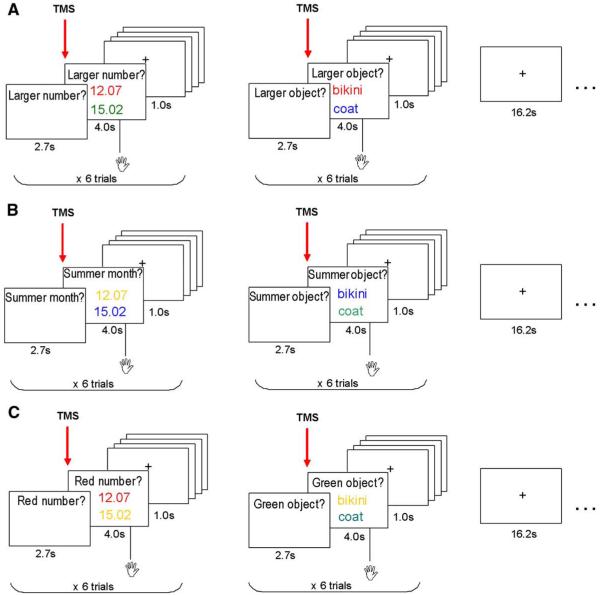Fig. 1.
Experimental design. In each trial, participants viewed pairs of stimuli presented one above the other with a fixation cross in the middle of the computer screen. Stimuli could be either two Arabic numbers (left column) or two object names (right column) presented in one of four possible colours (red, yellow, blue, green). Participants were instructed to indicate with a button press which of these stimuli was the correct response to a question consisting of two key words presented above the upper stimulus before and during the stimulus display. There were three types of tasks: for quantity tasks (A), there were four possible types of questions: ‘larger?’, ‘smaller?’, ‘more?’, ‘less?’. For non-quantity categorical tasks (B), there were four different types of questions: ‘summer month/object?’, ‘winter month/object?’, ‘sleeping time/object?’, ‘working time/object?’ (either ‘month’ or ‘object’ was displayed depending on the stimulus condition). For the stimulus-colour decision (C) the questions were: ‘blue/red/yellow/green number or object? The 3 different tasks (quantity, non-quantity categorical and colour-decision) with both stimuli (numbers and object names) were blocked (6 stimuli per block) and presented in pseudo-random. Each condition (e.g. quantity) was first presented with numerical stimuli, e.g. ‘larger number?’ (or object names, e.g. ‘larger object?’) and followed by another block with object names (or numerical stimuli) in a counterbalanced order. Presentation of blocks of the same task with both stimuli was followed by about 16-second rest period where subjects were asked to maintain fixation on a cross in the middle of the computer screen. Trials where the correct answer was the upper or the lower stimulus were presented in equal proportion. (For interpretation of the references to colour in this figure legend, the reader is referred to the web version of this article.)

